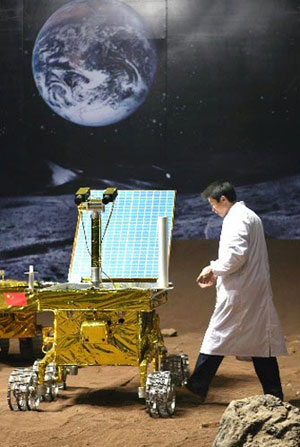
Currently scheduled for launch in December 2013 from the Xichang Satellite Launch Center in Sichuan province, the Chang’e 3 mission aims to land a Chinese rover on the Moon. If the mission is successful, it will be the first soft landing on the Moon since the Russian Luna 24 mission in 1976. Overseen by the China National Space Administration, the Chang’e program is following a step-wise approach to lunar exploration that could lead to the first taikonaut stepping onto the Moon by 2025.

The previous Chang’e 1 and 2 lunar orbiting missions, launched in 2007 and 2010, represented the first phase of the Chang’e program. Chang’e 3, to be followed by Chang’e 4, represent the second phase of the program, both involving rovers. The third phase, with Chang’e 5, will be a sample-return mission and is currently scheduled for 2017. After that, it is anticipated that a new program will commence, which might culminate in a manned landing.
Chang’e is the name of a Chinese goddess who ascended to the Moon after consuming an immortality pill and there befriended a jade rabbit who was already a lunar resident. The elements of this legend were relayed by NASA to the Apollo 11 crew ahead of the first Moon landing in 1969. Michael Collins famously responded “Okay. We’ll keep a close eye out for the bunny girl.”
The Chang’e 3 lander will set down in Sinus Iridum, which is an extension of Mare Ibrium and roughly opposite the Apollo 15 landing site near Hadley Rille.

Image Credit: Unknown (sourced from http://www.ecns.cn)
After landing, a solar-powered rover will roll off the lander and commence its mission, which is expected to last for at least three months, although presumably that will include a lot of down-time while the two-week-long lunar nights prevail.
The Chang’e 3 lander itself will continue to operate as a stationary science platform. It will be powered by a radioisotope thermoelectric generator and hence will be largely unaffected by the presence or absence of direct sunlight. The lander will operate a number of science instruments, including an optical telescope and a “soil probe” to conduct analyses of lunar regolith.
The Chang’e 3 rover will have a mass of 120 kilograms, including a 20 kg science payload. It is reported that it will explore widely over an area within a 5 kilometer radius of the lander. This sounds a little ambitious considering that the Spirit and Opportunity rovers traveled just 2 to 3 kilometers over their first year of operation, but the Chang’e 3 rover will have more advanced technology and more solar energy to draw upon.
The rover will also have autonomous hazard avoidance and navigation capacity, but with a radio delay of only 1.3 seconds from Earth, it will be mostly under the direct control of an Earth-based driver.
The rover’s science payload will include an alpha particle X-ray spectrometer, which has been standard issue on all the NASA Mars rovers to date, to enable geochemical analyses. The rover will also have a radar device on its underside, to investigate the structure and depth of the lunar regolith as well as the underlying structure of the lunar crust.
Want to keep up-to-date with all things space? Be sure to “Like” AmericaSpace on Facebook and follow us on Twitter:@AmericaSpace



